ASUS MS238H Review - Slim and Affordable
by Brian Klug on December 24, 2010 1:47 AM ESTViewing Angles
First up in our objective analysis are viewing angles. We're on a TN panel here and thus shouldn't expect much in the way of excellent viewing angles, however the MS238H actually performs very well, potentially thanks in part to WLED backlighting. ASUS advertises 170 degrees horizontal and 160 degrees vertical with a 10:1 contrast ratio. That's a bit low of a cutoff contrast ratio for viewing angle consideration, but in the horizontal direction the MS238H performs very well.
Vertically we see what we're used to with TN panels and get serious color distortion when viewed from extreme angles below the display, but not much when we view it from extreme angles above.
Color Gamut
Next up are the ever-important color quality metrics. As usual, we report two main quality metrics: color accuracy (Delta-E) and color gamut. Color gamut refers to the range of colors the display is able to represent with respect to some color space. In this case, our reference is the AdobeRGB 1998 color space, which is larger than the sRGB color space. Our percentages are thus reported with respect to AdobeRGB 1998, and larger is generally better unless you're dealing with sRGB content and colorspace-unaware software.
Color accuracy (Delta E) refers to the display’s ability to display the correct color requested by the GPU and OS. The difference between the color represented by the display, and the color requested by the GPU is our Delta-E, and lower is better here. In practice, a Delta E under 1.0 is perfect - the chromatic sensitivity of the human eye is not great enough to distinguish a difference. Moving up, a Delta E of 2.0 or less is generally considered fit for use in a professional imaging environment - it isn’t perfect, but it’s hard to gauge the difference. Finally, Delta E of 4.0 and above is considered visible with the human eye. Of course, the big consideration here is frame of reference; unless you have another monitor or some print samples like a Gretag Macbeth color checker card to compare your display with, you might not notice.
As I mentioned in our earlier reviews, we’ve updated our display test bench. We’ve deprecated the Monaco Optix XR Pro colorimeter in favor of an Xrite i1D2 since there are no longer up-to-date drivers for modern platforms.
For these tests, we calibrate the display and try to obtain the best Delta-E we can get at both 200 nits of brightness for normal use, and 100 nits for print brightness. We target D65 and a gamma of 2.2, but sometimes the best performance lies at native temperature and another gamma, so we try to find what absolute absolute best-case performance for each display. We also take an uncalibrated measurement to show performance out of the box using either the manufacturer supplied color profile, or a generic one with no LUT data. For all of these, dynamic contrast is disabled, and displays are left to settle for a half hour after making changes. Of course, the MS238H is LED backlit so settling time is essentially instantaneous, as compared to CCFLs that often take a half hour or more to settle.
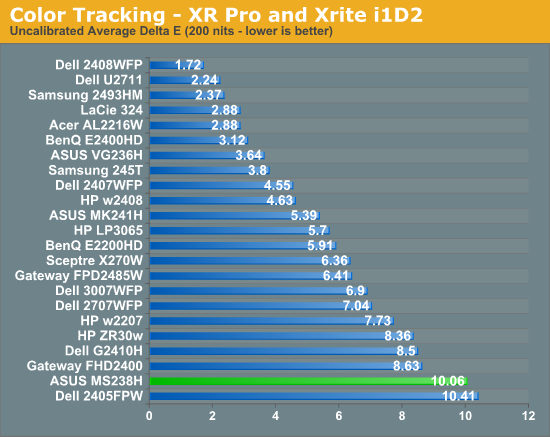

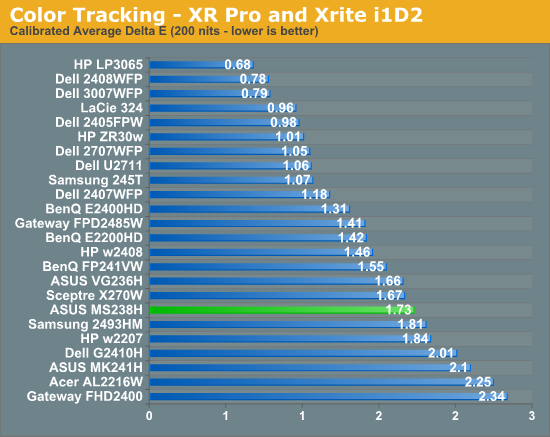
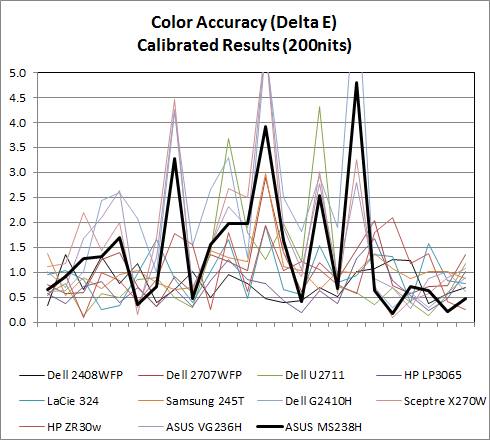
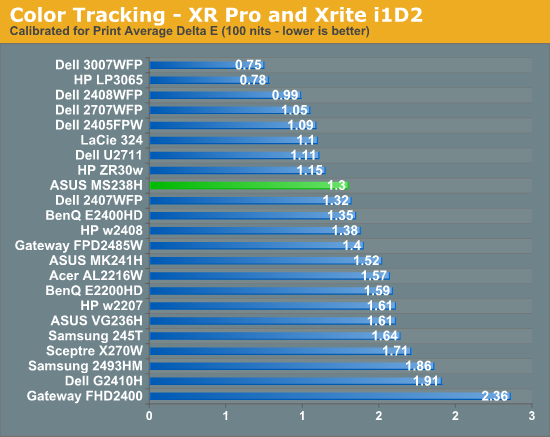
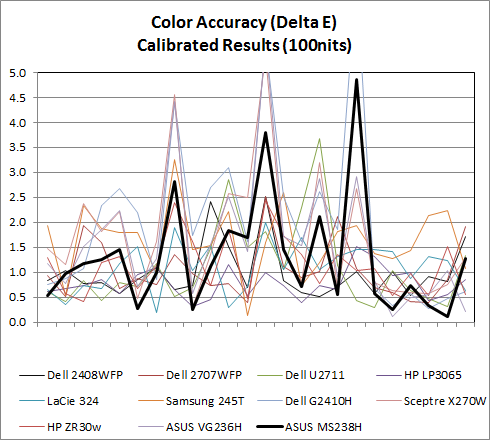
Uncalibrated and set to 200 nits, the MS238H is among the worst we've seen. Out of the box, the display is noticeably blueish. Initial measurements put white point around 7300K. After tweaking the RGB controls to nail D65, 200 nits, and a few calibration tweaks later, the MS238H actually performs pretty decent, with a Delta-E of 1.73. It's nothing stellar, but not bad considering our comparison is chock-full of IPS panels. Performance improves a bit at 100 nits, moving the MS238H almost up into IPS territory.
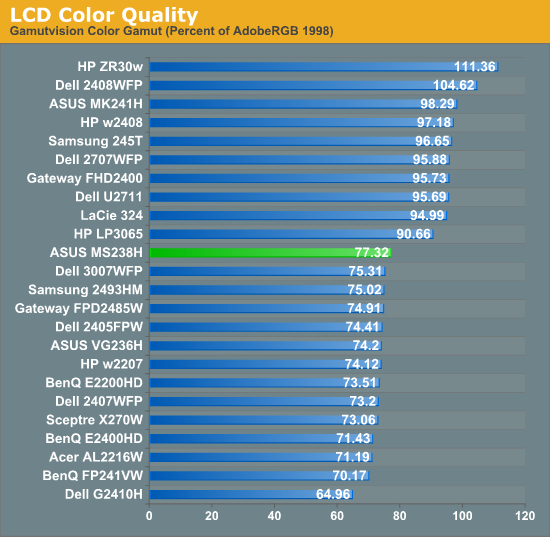
When it comes to gamut, the MS238H actually leads our stairstep-pattern of display results. Gamut could be better if the MS238H had RGB LED backlighting instead of WLED, but again this is a budget monitor with slim profile and power-sipping priorities.








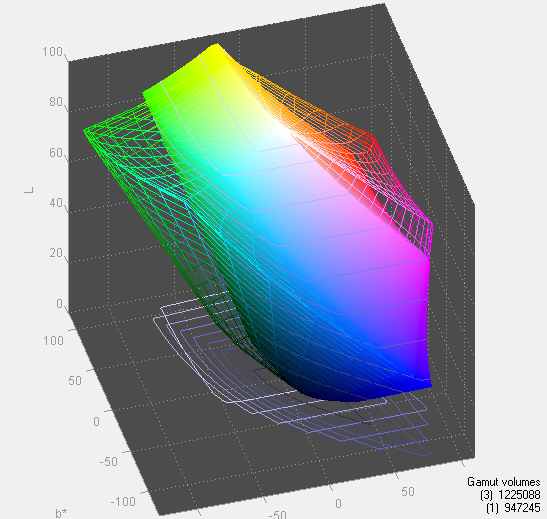








38 Comments
View All Comments
StrangerGuy - Friday, December 24, 2010 - link
Would I even bother with any TN when I can get $190 IPS Dell U2211H?sprockkets - Saturday, December 25, 2010 - link
Because it costs $240 and isn't LED backlit???Solidstate89 - Sunday, December 26, 2010 - link
Why would you want an LED backlit IPS monitor?You can go look at Anand's review of the Apple monitor. It's one of, if not the only IPS monitor that uses LED for backlighting and it sucks compared to something like a Dell Ultrasharp or HP's IPS monitors.
MrCoyote - Sunday, December 26, 2010 - link
What is needed is local-dimming LED with IPS panel. Where there independent groups of LED's that can be turned on and off. That is the only way to get consistent black level and higher contrast ratio.There is also the NEC 23" IPS EA231WMi which is a CCFL IPS panel that has got just as good of reviews as the other brands. NEC is about to release an LED backlit version "EA232WMi".
Stimpy88 - Friday, December 24, 2010 - link
I just dont get why this TN pannel crap is all there is these days. I have a lovely HP 24" monitor, but I am DESPERATE to upgrade to either another 24" or even better, a 26" one.I want it to be IPS, 120Hz, wide colour gamut, a good responce time, Displayport and HDMI/DVI inputs, and dont care if its 1mm thick or 100mm, or how pretty the case that it comes in looks.
But this simply does not exist! I have money, don't any manufactures want it?
FATCamaro - Friday, December 24, 2010 - link
This. Want a 120 Hz IPS or high end TN similar screen.solgae1784 - Friday, December 24, 2010 - link
Not sure if it's still true to this day, but I thought the input lag for IPS panels was worse compared to TN panels, which makes the IPS panels not very well suited for FPS and fighting games where gamers demand near-precise response time since even a 1-2 frame lag (~16.67ms on 60 frames) can make a difference between successful attacks and failed attacks (e.g. Tekken), or viewing high-motion contents. Today's panels might have improved on this.Sabresiberian - Friday, December 24, 2010 - link
IPS panels have come a long way and can be quite playable even by picky gamer standards, in terms of response time. It used to be a serious consideration, and one must still pay attention - I doubt any budget level IPS screen is going to have a decently low response time.Other facts are also worth considering - not all IPS screens are better than all TNs, and TNs are far better than they used to be in terms of color reproduction (their main weak point). Just jumping on to a cheap IPS because it is an IPS just doesn't make sense, especially if cost is a major factor.
1920x1080 is below my standards, as is .265 mm pixel pitch. That pixel pitch gives me the visual sense that I'm looking through a very fine mesh screen door.
;)
nwrigley - Friday, December 24, 2010 - link
"I want it to be IPS, 120Hz, wide colour gamut, a good responce time, Displayport and HDMI/DVI inputs, and dont care if its 1mm thick or 100mm, or how pretty the case that it comes in looks."I couldn't agree more.
I've had the same 21" Samsung 215TW for 5+ years now simply because nothing significantly better has come out. If anything, with more and more TN panels, 16:9 ratio, and shiny coatings things have gotten worse.
Back when I bought my current monitor I thought I'd be replacing it with an SED or OLED panel by now, but obviously that hasn't happened. I guess companies realized that they can roll out cheap monitors with shiny paint and a "1080p!" sticker and people will buy it, so why bother making better products?
Blipton - Friday, December 24, 2010 - link
LCD power draw figures for Dell U2711 don't make any sense at all.